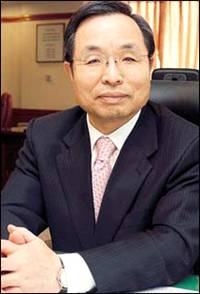|
|
South Korea: Pension Plan Key to
Happy Retirement
By Chang-lok Kim, Korea Times
South
Korea
October
25, 2005

Kim Chang-lok,
Deputy
Governor
Financial Supervisory Service
Retirement Pension Plan, a new employer-sponsored pension plan, is set to begin for the first time on Dec. 1. Thus, together with the government-run public pension plan and individual retirement plans already in place, the new pension plan completes the three layers of public-employer individual retirement safety nets that are found in most developed countries.
The National Assembly passed the legislation on the retirement pension plan on December 29, 2004. The essential goal of the legislation is to provide more secure post-retirement benefits.
Because most employers currently defer their pension obligations until their vested employees retire for a one-time, lump-sum payment, and some even allow their employees to "cash in" their vested years of service well before they reach retirement age, retirement benefits have not always been a sure thing.
Under the new pension scheme, an employer and employees may agree to set up a pension plan and make regular contributions to the plan, with independent outside fiduciaries administering and protecting the plan assets.
The new pension plan provides for two general types of pension plans commonly known as the defined benefit plan and the defined contribution plan and leaves it up to the employer and the employees to decide which plan suits them best.
They may also select to stay with the lump-sum retirement payment scheme already in place.
Under the defined benefit plan, the benefits that a vested employee receives after retirement are defined and typically determined on the basis of the final salary and the number of years of service. The contribution approach or the funding method elected for a defined benefit plan may vary from time to time and from one employer to another. But all defined benefit plans are supposed to provide the vested employees with the benefits as defined by the plan after retirement.
Similarly, with the defined contribution plan, the employer makes annual contributions -- e.g., 1/12 of the annual salary of the vested employees-- to individual accounts established for each of the vested employees, who are then more or less responsible for allocating the contributions into various investments for retirement purposes.
The new pension plan also provides individual retirement accounts for employees who switch jobs and receive severance pay or other compensation from the previous employer for use after retirement.
There are many positive developments we can expect from the adoption of the new plan, not only for the asset management service industry, but also for the financial market as a whole.
For one, it will open up new growth opportunities for financial service providers with sizable pools of funds to manage for stable, long-term investments.
And as more workplaces adopt the new pension plans and more employees elect to contribute to their pension plans to secure postretirement benefits, we can expect to see the pools of funds grow in size over time.
The potential for growth is exemplified by the experience of the U.S. since the introduction of 401(k) plans, which grew immensely popular and fueled the growth of the equity markets and strong economic performance throughout the 1990s.
The size of pension plan assets in the U.S. was estimated at $6 trillion at the end of 2003, an amount equivalent to about 55 percent of the gross domestic product that year.
For Japan, the comparable figure was 77 trillion yen or 15.5 percent of its gross domestic product. In contrast, the figure for Korea is around 19.5 trillion won or 2.6 percent of the gross domestic product.
For our part, we have worked hard to come up with an effective and efficient regulatory framework for pension plans. Among the rules we expect to establish in the supervisory regulations later this month are the registration of pension plan administrators, managing and safeguarding plan assets, and the fiduciary duties of plan administrators and asset managers.
The need for sound and transparent pension accounting and actuarial standards is obvious as well.
We expect only sound and reputable financial service providers to be eligible to manage pension plan assets. As a way to further protect plan assets, there will be certain restrictions on the types of investment vehicles and the level of risks pension funds may take on. Appropriate disclosure requirements will also be set forth.
We will also support financial service providers in such areas as system integration and staff training to help them prepare for the implementation of the new pension plan.
Both the regulators and the pension plan administrators -- the people who manage the plans -- certainly have a role to play in ensuring the success of the new retirement plan.
More importantly, those who decide to participate in the new pension plans will have to assume some responsibilities for safeguarding the accrued benefits.
As noted earlier, with the defined contribution plan the participant has much discretion over how the accrued benefits are invested, and there is no fixed amount of benefits guaranteed at retirement.
So it does place some burden on those participating in the new pension plan to take the due care to understand it, stay abreast of market developments, and make prudent investment decisions.
We are certainly prepared to do our part and work closely with government agencies as well as public and private institutions to help improve public understanding of the new retirement plan and make sure it is administered in a safe and sound manner.
|
|



